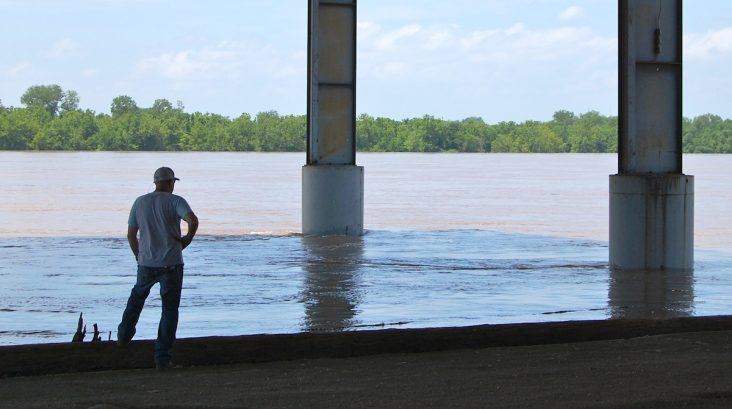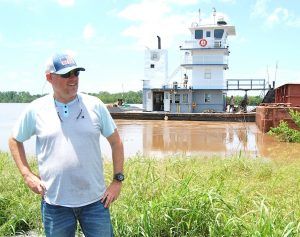Record flooding could close Arkansas River port operations for many months
by May 24, 2019 4:42 pm 4,666 views

Marty Shell, president of Van Buren-based Five Rivers Distribution, which manages the port of Fort Smith and has port operations in Van Buren, watches as rising waters threaten to overtake a loading-offloading facility in Van Buren.
The port of Fort Smith is underwater. Port operations in Van Buren are either underwater or will be by Sunday (May 26). The port of Little Rock is likely to remain dry, but potentially record flooding means all Arkansas River ports may not see business as usual for many months.
Bryan Day, executive director of the port of Little Rock, told Talk Business & Politics he is not worried about flooding at the port. They have pulled 85 barges into a slackwater harbor and secured them.
“But we’re worried. Don’t get me wrong,” Day said. “It [flooding] will impact tonnage on the river and it will impact the moving of resources, but it should start moving again if it will ever stop raining.”
Tonnage on the river totaled 3.897 million tons in the first four months of 2019, just ahead of the 3.88 million tons during the same period in 2018. A total of 10.932 million tons were shipped in all of 2018, down from 11.918 million in 2017 and from 11.542 million tons in 2016.
The Arkansas River system (McClellan-Kerr Arkansas River Navigation System, or MKARNS) is 445 miles long and stretches from the confluence of the Mississippi River to the Port of Catoosa near Tulsa, Okla. The controlled waterway has 18 locks and dams, with 13 in Arkansas and five in Oklahoma. The river also has five ports: Pine Bluff, Little Rock, Fort Smith, Muskogee, Okla., and the Tulsa Port of Catoosa in Oklahoma.
‘HARD TO PREDICT’
Welspun, the Mumbai, India-based pipemaker, has a large operation at the port which at one time employed more than 800 people. Day said barges and warehouses at the port have enough raw materials to keep Welspun working for about six months. Will that be enough?
“It’s hard to predict what the river will do,” Day said.
It’s a different story up the river in Fort Smith and Van Buren. The U.S. Corps of Engineers is predicting the Arkansas River in the Fort Smith area will crest Sunday at 41 feet, well above the flood stage of 22 feet and above the area record of 38.1 feet. Early Friday (May 24) the level was 33 feet.

Marty Shell, president of Van Buren-based Five Rivers Distribution, which manages the port of Fort Smith and has port operations in Van Buren, has for the past three days shifted a majority of his 23 employees from normal port work to building makeshift levees around his Van Buren facility. The nearby Arkhola Sand & Gravel operation has closed, and Consolidated Barge – immediately adjacent to Five Rivers – is underwater.
“We decided to fight this. And I think we could have beat a 34 (foot water level) or 35 or maybe even a 36, but we will not make a 41,” Shell said Friday. “I’ve probably spent at least $100,000 on flood prevention in the past three days, but we will not make a 41. We’re gonna build it up best we can, and then get out.”
GOVERNMENT HELP
Shell said U.S. Rep. Steve Womack, R-Rogers, called him Friday to ask about flooding impact on the two ports. Shell said he told Womack the “feds are going to have to step up in a big way after this,” and added that Womack promised to do all he could to get funding help.
“We’re going to need the help of the federal government and the state government to get through this. … FEMA [Federal Emergency Management Administration] insurance is maxed out at $500,000, and when you consider that one of the barges you see here is around $1 million, that won’t touch it [potential losses]. If we survive this long after the water is gone, we’ll need that [government] help,” Shell said.
Flooding in 2015 slowed river operations almost six months with tonnage shipped that year falling 15% to 9.962 million tons. But river levels that year didn’t come close to what is predicted in the next few days.
“If this thing goes to 41, if it’s as catastrophic as they say it will be, I’d say six to eight months,” Shell said when asked how long river commerce could be closed. “You have to remember that they [Corps] won’t let barges move again until the flow gets to around 125,000 cubic feet per second. … So it doesn’t matter how hard you were hit, if nothing moves, you aren’t doing business.”
Flows at Trimble Lock and Dam near Fort Smith on Thursday (May 23) were about 270,000 cubic feet per second (cfs) and were expected to peak Monday at about 560,000 cfs, according to the Corps. Flows at Murray Lock and Dam at Little Rock were 180,000 cfs and are expected to peak May 31 at about 515,000 cfs. Flows at Emmett Sanders Lock and Dam at Pine Bluff were 180,000 cfs on Thursday and expected to peak June 2 at 490,000 cfs.
INFRASTRUCTURE CONCERN
Day said another unknown is the extent of damage at the Webbers Falls Lock & Dam in Oklahoma that was hit Thursday by two loaded barges. He said infrastructure failure at any point jeopardizes the entire system.
“The consequences of failure anywhere on the navigation channel would be far reaching. I pray and hope there is no significant damage and when they pull those barges off [Webber Falls Lock & Dam] that we are okay,” Day said.
A 2015 study conducted by the University of Arkansas for the Maritime Transportation Research & Education Center found that more than 55,000 jobs nationwide are tied to the Arkansas River system.
“Our study considers regional economic impacts from hydropower energy generation, USACE O&M expenditures, private sector investment expenditures, port activities, shippers’ activities, transportation cost savings, and recreation benefits related to the MKARNS. Our findings show the MKARNS contributes total impacts of $8.5 billion in sales, $4.3 billion in GDP, and 55,872 jobs to the national economy,” according to the study.
The study also found that river operations reduce wear and tear on U.S. rail and road systems.
“In 2013, the total tonnage throughout the entire MKARNS was approximately 12.1 million tons. On land, 120,781 railcars or 483,121 semi-trucks would be needed to transport an equivalent tonnage.”
